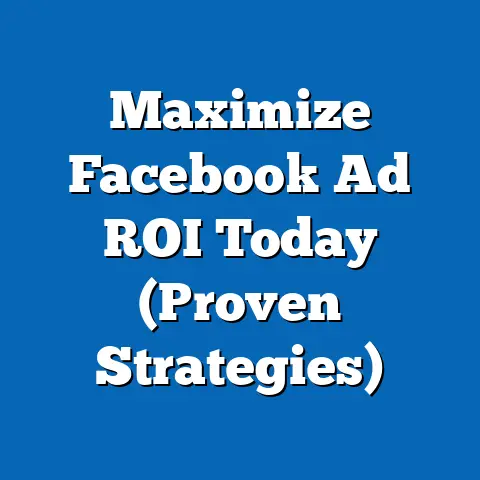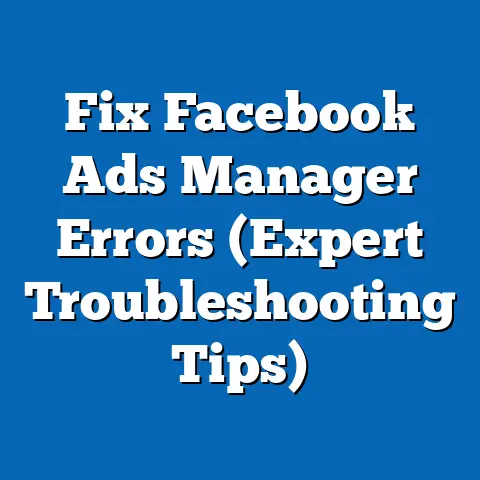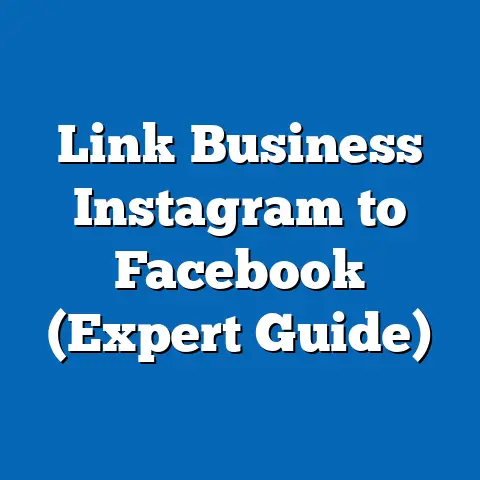Delete Facebook Ad Campaigns with Confidence (Expert Guide)
Have you ever felt buried under a mountain of Facebook ad campaigns, some thriving, others… well, not so much? I know I have. There I was, staring at a screen filled with campaigns, ad sets, and ads, feeling a mix of overwhelm and anxiety. Some campaigns were humming along, bringing in leads and sales. But others? They were just draining my budget, offering little in return. It’s a common scenario for many digital marketers and business owners. The frustration of knowing you’re throwing money away, the confusion over what metrics to focus on, and the nagging feeling that you should be doing something different – it’s a heavy burden.
The truth is, sometimes the best thing you can do for your Facebook advertising strategy is to hit the “delete” button. It sounds simple, but it can be surprisingly difficult. We get attached to our creations, even the ones that aren’t working. We worry about wasted effort, about admitting defeat. But holding onto underperforming campaigns is like clinging to a leaky bucket – you’re just losing money and energy.
In this guide, I’m going to walk you through the process of deleting Facebook ad campaigns with confidence. We’ll cover when it’s the right move, how to overcome the mental hurdles, the exact steps to take, and what to do after you’ve freed yourself from those underperforming ads. My goal is to empower you to make strategic decisions about your campaigns, so you can focus your resources on what’s actually driving results.
Understanding When to Delete a Facebook Ad Campaign
Knowing when to pull the plug on a campaign is crucial. It’s not about giving up easily; it’s about being strategic and data-driven. I’ve seen countless businesses waste money and time on campaigns that were clearly not working, simply because they were afraid to admit defeat. So, how do you know when it’s time to say goodbye? Here are some key indicators:
-
Consistently Low Engagement Rates: Are people simply scrolling past your ads without a second glance? If your click-through rate (CTR) is consistently below your industry benchmark (which varies, but generally a CTR below 1% is concerning), and your engagement rate (likes, comments, shares) is abysmal, it’s a sign that your ad creative, targeting, or offer isn’t resonating with your audience.
-
Poor Conversion Metrics: This is the bottom line. Are your ads driving the desired action? If you’re running a lead generation campaign and you’re not getting leads, or you’re running a sales campaign and sales are non-existent, something is fundamentally wrong. Track your cost per acquisition (CPA) and return on ad spend (ROAS). If your CPA is too high or your ROAS is too low, it’s time to re-evaluate.
-
Significant Change in Marketing Strategy: Sometimes, the reason to delete a campaign isn’t about performance, but about alignment. Maybe your business has pivoted, your target audience has shifted, or you’re launching a new product line. If your existing campaigns no longer align with your overall marketing strategy, it’s time to sunset them. I once worked with a client who completely changed their product offering. Their existing Facebook campaigns, which were focused on the old product, were no longer relevant. We had to delete them and start fresh with a new strategy.
-
A/B Testing Failure: One of the best ways to optimize your Facebook ads is through A/B testing, by experimenting with different ad creatives, copy, and audience targetings. If you’ve run multiple A/B tests and none of your variations are showing improvement, it’s a strong indication that the underlying concept is flawed.
Consistently Low Engagement Rates: Are people simply scrolling past your ads without a second glance? If your click-through rate (CTR) is consistently below your industry benchmark (which varies, but generally a CTR below 1% is concerning), and your engagement rate (likes, comments, shares) is abysmal, it’s a sign that your ad creative, targeting, or offer isn’t resonating with your audience.
Poor Conversion Metrics: This is the bottom line. Are your ads driving the desired action? If you’re running a lead generation campaign and you’re not getting leads, or you’re running a sales campaign and sales are non-existent, something is fundamentally wrong. Track your cost per acquisition (CPA) and return on ad spend (ROAS). If your CPA is too high or your ROAS is too low, it’s time to re-evaluate.
Significant Change in Marketing Strategy: Sometimes, the reason to delete a campaign isn’t about performance, but about alignment. Maybe your business has pivoted, your target audience has shifted, or you’re launching a new product line. If your existing campaigns no longer align with your overall marketing strategy, it’s time to sunset them. I once worked with a client who completely changed their product offering. Their existing Facebook campaigns, which were focused on the old product, were no longer relevant. We had to delete them and start fresh with a new strategy.
A/B Testing Failure: One of the best ways to optimize your Facebook ads is through A/B testing, by experimenting with different ad creatives, copy, and audience targetings. If you’ve run multiple A/B tests and none of your variations are showing improvement, it’s a strong indication that the underlying concept is flawed.
Data Points and Case Studies:
Consider this: A study by HubSpot found that companies that A/B test their marketing emails generate 36% more leads. The same principle applies to Facebook ads. Regularly testing and optimizing your campaigns is essential, and sometimes that means admitting that an idea isn’t working and moving on.
I recall a case where a client was running a campaign promoting a specific product feature. Despite trying different ad creatives and targeting options, the campaign consistently underperformed. After analyzing the data, we realized that the product feature wasn’t as popular as we had initially thought. We deleted the campaign and reallocated the budget to promoting other, more popular features, which resulted in a significant increase in sales.
The Importance of Regular Assessment:
Think of your Facebook ad campaigns as a garden. You need to regularly weed out the underperforming plants to allow the healthy ones to thrive. By regularly assessing your campaign performance, you can prevent wasted ad spend and keep your marketing strategy agile. This means setting up regular reporting, monitoring key metrics, and being willing to make tough decisions.
Takeaway: Don’t be afraid to delete underperforming campaigns. It’s a strategic move that can free up your budget and allow you to focus on what’s working. Look for low engagement, poor conversion metrics, misalignment with your strategy, and failed A/B tests as signs that it’s time to say goodbye.
The Psychological Barriers to Deleting Campaigns
Okay, so logically, you know it’s time to delete that underperforming campaign. But emotionally, it’s tough, right? I get it. I’ve been there. There are several psychological barriers that can make it difficult to hit that delete button:
-
Attachment to Past Efforts: You poured hours into creating that campaign. You researched your audience, wrote compelling copy, designed eye-catching visuals. It’s hard to let go of something you’ve invested so much time and energy into. I remember one campaign I spent weeks crafting, only to have it completely flop. It felt like a personal failure.
-
Fear of Loss: You might be thinking, “What if it starts working later?” Or, “What if I’m missing out on potential customers?” This fear of loss can prevent you from making rational decisions.
-
The Stigma of “Failure”: No one wants to admit that their campaign didn’t work. There can be a sense of shame or embarrassment associated with deleting a campaign. You might worry about what your boss or colleagues will think.
Attachment to Past Efforts: You poured hours into creating that campaign. You researched your audience, wrote compelling copy, designed eye-catching visuals. It’s hard to let go of something you’ve invested so much time and energy into. I remember one campaign I spent weeks crafting, only to have it completely flop. It felt like a personal failure.
Fear of Loss: You might be thinking, “What if it starts working later?” Or, “What if I’m missing out on potential customers?” This fear of loss can prevent you from making rational decisions.
The Stigma of “Failure”: No one wants to admit that their campaign didn’t work. There can be a sense of shame or embarrassment associated with deleting a campaign. You might worry about what your boss or colleagues will think.
Overcoming These Barriers:
The key to overcoming these psychological barriers is to reframe your mindset. Here are a few techniques that have worked for me:
-
View Deletions as a Strategic Move: Instead of seeing deleting a campaign as a failure, view it as a strategic move that allows you to reallocate resources to more promising initiatives. It’s about being efficient and data-driven.
-
Focus on Future Growth: Don’t dwell on the past. Focus on what you can learn from the experience and how you can use that knowledge to improve your future campaigns.
-
Celebrate Small Wins: Acknowledge and celebrate the small wins you achieve along the way, such as identifying a problem early, testing a new hypothesis, or optimizing a different campaign.
-
Separate Yourself from Your Work: Remember that your value as a marketer or business owner isn’t tied to the success of any one campaign. It’s about your ability to learn, adapt, and innovate.
View Deletions as a Strategic Move: Instead of seeing deleting a campaign as a failure, view it as a strategic move that allows you to reallocate resources to more promising initiatives. It’s about being efficient and data-driven.
Focus on Future Growth: Don’t dwell on the past. Focus on what you can learn from the experience and how you can use that knowledge to improve your future campaigns.
Celebrate Small Wins: Acknowledge and celebrate the small wins you achieve along the way, such as identifying a problem early, testing a new hypothesis, or optimizing a different campaign.
Separate Yourself from Your Work: Remember that your value as a marketer or business owner isn’t tied to the success of any one campaign. It’s about your ability to learn, adapt, and innovate.
I once worked with a team that had a “failure wall” where they posted screenshots of their worst-performing ads. Instead of being ashamed of these failures, they used them as a learning opportunity. They would analyze what went wrong and share their insights with the rest of the team. This created a culture of experimentation and learning, where failure was seen as a valuable part of the process.
Fostering a Positive Mindset:
Creating a positive mindset around campaign performance is essential for long-term success. Here are a few tips:
-
Set Realistic Expectations: Don’t expect every campaign to be a home run. Some campaigns will work, and some won’t. That’s just the nature of advertising.
-
Focus on the Process: Focus on the process of creating, testing, and optimizing your campaigns. If you’re following a sound process, you’re more likely to achieve success over time.
-
Celebrate Learning: Celebrate the lessons you learn from both successful and unsuccessful campaigns. Every campaign is an opportunity to learn something new.
Set Realistic Expectations: Don’t expect every campaign to be a home run. Some campaigns will work, and some won’t. That’s just the nature of advertising.
Focus on the Process: Focus on the process of creating, testing, and optimizing your campaigns. If you’re following a sound process, you’re more likely to achieve success over time.
Celebrate Learning: Celebrate the lessons you learn from both successful and unsuccessful campaigns. Every campaign is an opportunity to learn something new.
Takeaway: Don’t let psychological barriers prevent you from deleting underperforming campaigns. Reframe your mindset, focus on future growth, and celebrate learning. Remember that deleting a campaign is a strategic move, not a personal failure.
Here’s a step-by-step guide on how to delete a Facebook ad campaign through the Ads Manager interface:Step 1: Accessing Ads Manager and Locating the Campaign
- Log in to Facebook: Go to Facebook.com and log in to your account.
- Navigate to Ads Manager: In the left-hand menu, look for “Ads Manager.” If you don’t see it, click “See More” to expand the menu.
- Select Your Ad Account: If you manage multiple ad accounts, make sure you’ve selected the correct one from the dropdown menu in the upper left corner.
- Locate the Campaign: In the Ads Manager interface, you’ll see a list of your campaigns. You can filter by campaign name, status, or date range. Use the search bar to quickly find the campaign you want to delete.
Step 2: Analyzing the Campaign Performance Data to Confirm the Decision
Before you delete anything, take one last look at the data to make sure you’re making the right decision.
- Select the Campaign: Click on the campaign name to view its details.
- Review Key Metrics: Pay close attention to the following metrics:
- Reach: How many people saw your ads?
- Impressions: How many times were your ads displayed?
- Click-Through Rate (CTR): What percentage of people who saw your ad clicked on it?
- Cost Per Click (CPC): How much did each click cost you?
- Conversion Rate: What percentage of people who clicked on your ad completed the desired action (e.g., filled out a form, made a purchase)?
- Cost Per Acquisition (CPA): How much did it cost you to acquire a customer or lead?
- Return on Ad Spend (ROAS): How much revenue did you generate for every dollar you spent on ads?
- Compare to Benchmarks: Compare these metrics to your industry benchmarks and your own historical data. Are they significantly lower than expected?
- Consider the Trend: Look at the trend over time. Is the campaign performance improving or declining? If it’s consistently declining, it’s a strong indication that it’s time to delete it.
- Reach: How many people saw your ads?
- Impressions: How many times were your ads displayed?
- Click-Through Rate (CTR): What percentage of people who saw your ad clicked on it?
- Cost Per Click (CPC): How much did each click cost you?
- Conversion Rate: What percentage of people who clicked on your ad completed the desired action (e.g., filled out a form, made a purchase)?
- Cost Per Acquisition (CPA): How much did it cost you to acquire a customer or lead?
- Return on Ad Spend (ROAS): How much revenue did you generate for every dollar you spent on ads?
Step 3: The Deletion Process
Okay, you’ve analyzed the data, you’ve made your decision. It’s time to pull the trigger.
- Select the Campaign: In the Ads Manager interface, check the box next to the campaign you want to delete.
- Deactivate the Campaign: Instead of deleting, I usually recommend deactivating the campaign first. This will stop the campaign from running and prevent any further ad spend. To deactivate, click the toggle switch next to the campaign name to turn it off. It will show as “Inactive”.
- Delete (Optional): Once the campaign is deactivated, you have the option to permanently delete it. To do this, select the deactivated campaign, click the three dots “…” button, and choose “Delete.”
- Confirm the Deletion: Facebook will ask you to confirm that you want to delete the campaign. Be sure you want to proceed, as this action cannot be undone.
Step 4: Keeping Track of Deleted Campaigns
Even though you’ve deleted the campaign, it’s important to keep a record of it for future reference.
- Create a Spreadsheet: Create a spreadsheet or document to track your deleted campaigns. Include the following information:
- Campaign Name
- Date Deleted
- Reason for Deletion
- Key Metrics (Reach, Impressions, CTR, CPC, Conversion Rate, CPA, ROAS)
- Lessons Learned
- Archive the Campaign (Optional): Instead of deleting the campaign, you can archive it. This will remove it from your active campaigns but preserve the data for future analysis. To archive a campaign, select it and click “Archive.”
- Campaign Name
- Date Deleted
- Reason for Deletion
- Key Metrics (Reach, Impressions, CTR, CPC, Conversion Rate, CPA, ROAS)
- Lessons Learned
Visual Aids (Description):
- Screenshot of Ads Manager Interface: Show a screenshot of the Facebook Ads Manager interface, highlighting the location of the campaign list, the toggle switch for deactivating campaigns, and the “Delete” button.
- Screenshot of Campaign Performance Data: Show a screenshot of the campaign performance data, highlighting the key metrics mentioned above.
- Screenshot of Spreadsheet: Show a screenshot of a sample spreadsheet for tracking deleted campaigns.
Takeaway: Deleting a Facebook ad campaign is a straightforward process. Just follow these steps: access Ads Manager, analyze the data, deactivate the campaign, delete (optional), and keep track of your deleted campaigns. Remember to deactivate before deleting, and consider archiving instead of deleting if you want to preserve the data.
What to Do After Deleting a Campaign
You’ve deleted the campaign. Now what? Don’t just move on to the next shiny object. Take some time to reflect on the experience and learn from it.
-
Conduct a Post-Mortem Analysis: This is crucial. Take some time to analyze why the campaign failed. What went wrong? Was it the targeting? The ad creative? The offer? The landing page? Be honest with yourself and identify the root causes of the problem.
-
Identify Lessons Learned: What lessons can you learn from this experience? What would you do differently next time? Write down your key takeaways and share them with your team.
-
Reallocate Budget: Now that you’ve freed up some budget, reallocate it to your higher-performing campaigns or test new ad formats based on your previous learnings.
-
Test New Ideas: Don’t be afraid to experiment with new ideas. The key to success in Facebook advertising is to constantly test and optimize your campaigns.
Conduct a Post-Mortem Analysis: This is crucial. Take some time to analyze why the campaign failed. What went wrong? Was it the targeting? The ad creative? The offer? The landing page? Be honest with yourself and identify the root causes of the problem.
Identify Lessons Learned: What lessons can you learn from this experience? What would you do differently next time? Write down your key takeaways and share them with your team.
Reallocate Budget: Now that you’ve freed up some budget, reallocate it to your higher-performing campaigns or test new ad formats based on your previous learnings.
Test New Ideas: Don’t be afraid to experiment with new ideas. The key to success in Facebook advertising is to constantly test and optimize your campaigns.
I remember one time when I deleted a campaign that was targeting a very broad audience. After analyzing the data, I realized that the campaign was generating a lot of impressions but very few clicks. I learned that I needed to be more specific with my targeting. I created a new campaign that targeted a much narrower audience based on their interests and demographics. The new campaign performed much better, generating a higher click-through rate and more conversions.
Actionable Next Steps:
- Schedule a Weekly Campaign Review: Set aside time each week to review your campaign performance and identify any underperforming campaigns.
- Create a Testing Plan: Develop a plan for testing new ad creatives, targeting options, and offers.
- Track Your Results: Keep track of your results and use the data to inform your future decisions.
Takeaway: Deleting a campaign is not the end of the story. It’s an opportunity to learn, adapt, and improve your Facebook advertising strategy. Conduct a post-mortem analysis, identify lessons learned, reallocate budget, and test new ideas.
Conclusion
Deleting Facebook ad campaigns doesn’t have to be a daunting task. By understanding when it’s the right move, overcoming the psychological barriers, following a step-by-step guide, and reflecting on the experience, you can approach campaign management with confidence. Remember that deleting a campaign is not a failure, but a strategic decision that enables growth and optimization in your marketing efforts. So, go ahead, take control of your Facebook advertising strategy, and don’t be afraid to hit that delete button when necessary. Your budget and your sanity will thank you for it!






